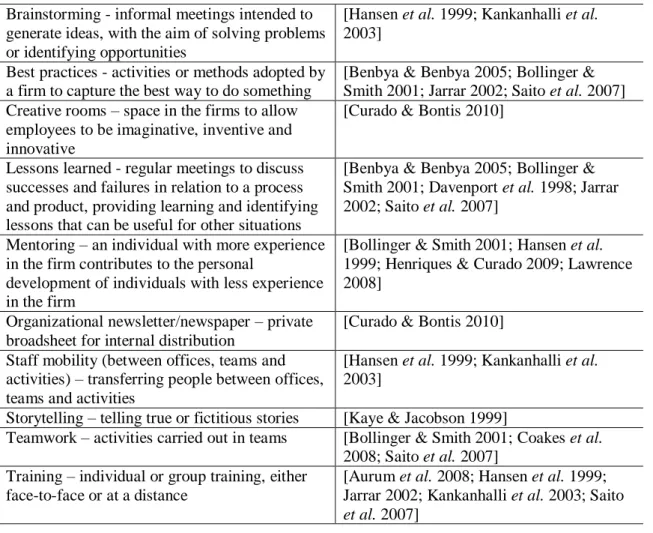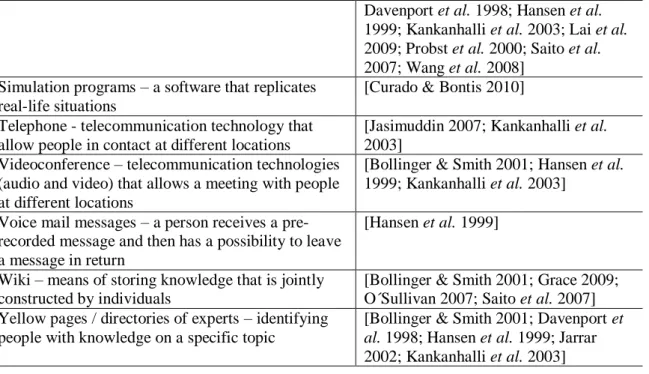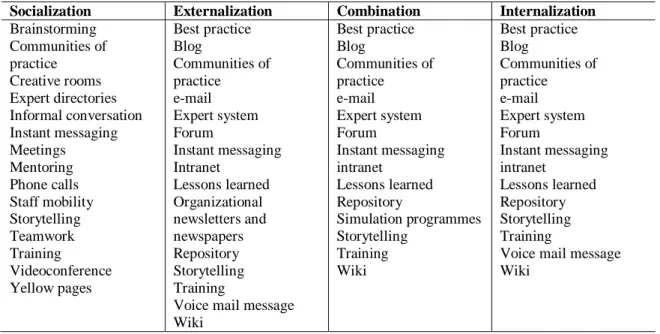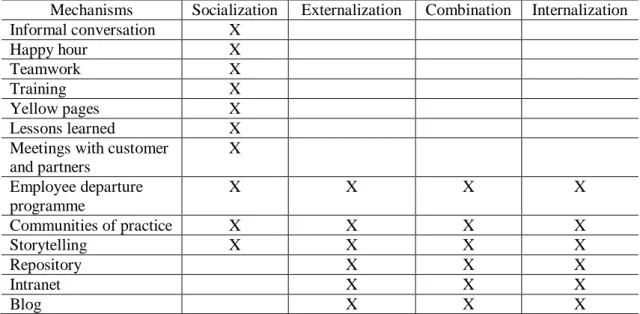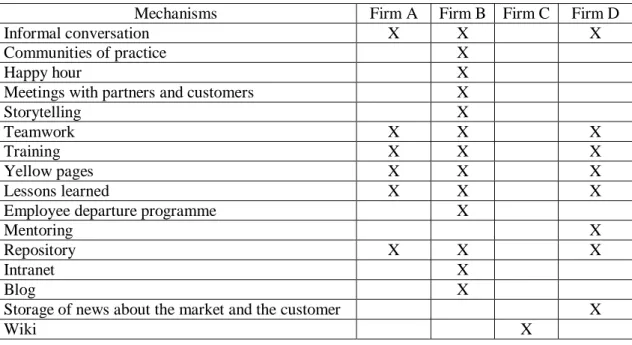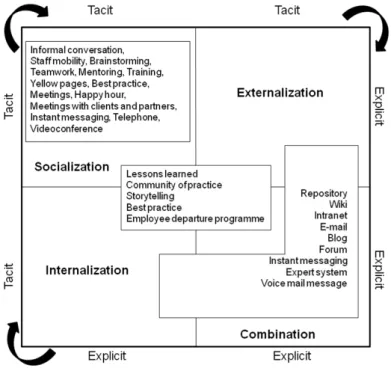Knowledge management mechanisms within the SECI model
CAPSI’2011
Mírian Oliveira 1, Antônio Carlos Gastaud Maçada 2, Carla Curado 3
1) Pontifícia Universidade Católica do Rio Grande do Sul, Porto Alegre, Brasil
miriano@pucrs.br
2) Universidade Federal do Rio Grande do Sul, Porto Alegre, Brasil
acgmacada@ea.ufrgs.br
3) Universidade Técnica de Lisboa, Lisboa, Portugal
ccurado@iseg.utl.pt
Abstract
Knowledge management mechanisms include the creation and sharing of knowledge, often addressing the conversion of tacit into explicit knowledge. When selecting the knowledge management mechanisms to adopt the firm will favour a particular mode of knowledge conversion. The main objective of this paper is to analyse mechanisms of knowledge management associated to the modes of knowledge conversion proposed by Nonaka [1994]. The research method adopted consisted of a multiple case study in four firms acting in Portugal. Data was collected by means of interviews and subsequent content analysis was preformed. Research findings show an association between mechanisms of knowledge management and modes of knowledge conversion. This study may serve as a guide for firms when choosing which knowledge management mechanisms to adopt. Limitations are presented at the end of the paper, as well as clear invitations for future work.
Key words: knowledge management, mechanisms, SECI model, Portugal
1. Introduction
Knowledge management (KM) is perceived by firms as a means of obtaining sustainable competitive advantage [Jasimuddin 2007]. Following Lee and Yang [2003 p.784], KM is “the collection of processes that govern the creation, dissemination and leveraging of knowledge to fulfil organizational objectives”.
Knowledge can be understood as information associated with the experience, context, interpretation and reflection of the individual [Davenport et al. 1998; Jarrar 2002]. Nonaka [1994] proposed the spiral of organizational knowledge creation, which considers both explicit knowledge and tacit knowledge. Explicit knowledge is easily structured and can be stored in documents and disseminated by the organization’s information systems [Shah et al. 2007]. In contrast, tacit knowledge is difficult to structure and share, since it is acquired by individuals through their experiences, skills and expertise [Shah et al. 2007].
The spiral of organizational knowledge creation covers four modes of knowledge conversion: socialization (from tacit to tacit), externalization (from tacit to explicit), combination (from explicit to explicit) and internalization (from explicit to tacit) [Nonaka 1994]. This phenomenon
is known as the SECI Model [Nonaka & Konno 1998]. These conversions occur in firms through KM mechanisms such as, for example, communities of practice and wikis. When a firm selects the mechanisms it will adopt it will also have to opt for a certain mode of knowledge conversion. That choice is not free from consequences, since the mechanisms that support the conversion of tacit and explicit knowledge are relevant to the performance of the firm [Wang et al. 2008].
The relationship between knowledge management mechanisms and modes of knowledge conversion should be further explored, thus, the main objective of this paper is to analyse mechanisms of knowledge management associated to the modes of knowledge conversion proposed by Nonaka [1994].
The paper is organized as follows. The next section (2) situates the paper within the broader literature on knowledge management, following by sections on the adopted research method (3), cases´ presentation (4) and the empirical results discussion (5). In the final sections, presents conclusions (6), and limitations and invites future work (7).
2. Knowledge management
This section is organized into three parts. Firstly, SECI Model is presented in section 2.1. Subsequently, section 2.2 contains a discussion of KM mechanisms, and section 2.3 associated SECI Model and KM mechanisms.
2.1 SECI Model
The classical classification by Polanyi categorizes knowledge into tacit and explicit [Nonaka 1994]. Explicit knowledge can be easily stored and disseminated through an organization’s information systems. Explicit knowledge can be expressed in words and numbers and shared through e.g. manuals or specifications [Nonaka & Konno 1998].
On the other hand, tacit knowledge consists of technical elements (know-how and skills) and cognitive (mental models such as paradigms and beliefs), it is not easily captured, represented or transmitted [Nonaka 1994]. Tacit knowledge is often more complex than explicit knowledge [Goh 2002] and may for example be expressed through the intuitions, insights and beliefs of individuals. Tacit knowledge, though harder to disseminate than explicit knowledge, is important to a firm since it cannot be easily copied by competitors and also because it includes the expertise of individuals, and thus becomes a competitive advantage.
Socialization consists of creating and sharing tacit knowledge through interaction between individuals, it implies the conversion of tacit knowledge into tacit knowledge. In this case the interaction occurs between individuals, i.e., experiences are shared between individuals. This interaction can be either between employees (carrying internal knowledge to the firm) or with customers and suppliers (involving knowledge coming from outside the firm) [Nonaka & Konno 1998; Ishikura 2004]. Socialization can occur through informal meetings, observation, imitation and practice [Nonaka & Takeuchi, 2004].
Externalisation involves turning tacit individual knowledge into explicit collective one. In this mode of conversion, knowledge passes from the individual to the group with the use of metaphors, analogies, concepts or models [Nonaka & Takeuchi 2004]. According to Nonaka and Konno [1998], two factors are critical for externalization: (1) conversion of tacit to explicit knowledge using techniques that help individuals to express their ideas in words, with concepts or visually, (2) conversion of the tacit knowledge of customers and experts into explicit knowledge.
Combination regards the systematisation of explicit knowledge; there is a conversion of explicit into explicit knowledge. In this case the knowledge surpasses from the group to the firm
[Nonaka & Takeuchi 2004] converting explicit knowledge into more complex forms. This is the phase the groups may use some external knowledge and combine it with the pre-existing internal one. Lessons learned and documented by different teams can be analyzed in order to generate new explicit knowledge for the firm.
Internalization is phase when explicit knowledge is converted into tacit knowledge. In this mode of conversion, knowledge flows from the firm to the individual [Takeuchi & Nonaka 2004]. This type of conversion is related to "learning by doing" [Ishikura 2004]. In order to internalise the individual needs to identify the relevant knowledge [Nonaka & Konno 1998].
The implementation of knowledge management in a firm should consider the different modes of knowledge conversion, which implies the adoption of different knowledge management mechanisms. While the transfer of tacit knowledge requires mechanisms that allow for interaction between people, explicit knowledge can be, for example, documented in files. The mechanisms vary from those that depend heavily on information technology to those that require face-to-face interaction [Chua & Goh 2008]. Although, information technology (IT) alone may not be sufficient for knowledge management [Chua 2004; Wang et al. 2008], IT is a relevant enabler for many mechanisms [Alavi & Leidner 2001]. Some technologies initially developed for other purposes, such as for supporting collaborative work, have been adopted by KM [Marwick, 2001]. The firm provides a context for individuals to share and create new knowledge [Nonaka, 1994].
2.2 Knowledge management mechanisms
There are several KM mechanisms and authors interpret them in different ways. Hansen et al. [1999] analyse the strategies for managing knowledge (personalization and codification). According to these authors, firms adopt ways (such as meetings) and IT (such as e-mail) to manage their knowledge. Bollinger and Smith [2001] classify KM mechanisms in non-technology (such as mentoring programs) and non-technology (such as intranet using). Kankanhalli et al. [2003] analyse the IT (such as videoconference) to support KM initiatives (such as communities of practice). Saito et al. [2007] offer a conceptual map of KM strategy, this map classify KM instruments in KM practices (such as lessons learned) and KM technologies (such as intranet). Given the differences in the nomenclature, for this research purpose KM mechanisms are considered to be any deliberate interventions to support the creation, storing, sharing and application of knowledge, including practices and technologies to implement KM. The KM mechanisms identified in the literature and adopted in this research can be classified in KM practices and KM technologies [Saito et al., 2007]. The difference stands in the use of technology; practices can use the technology, but they can be adopted without technology support. For example, informal conversation can be face-to-face, but also can be by telephone. The KM practices, most common to adopt, were identified in the literature (Table 1).
KM practice Authors
Communities of practice - individuals united by a common interest and expertise to share knowledge
[Aurum et al. 2008; Benbya & Belbaly 2005; Brown & Duguid 2001; Chua & Goh 2008; Kankanhalli et al. 2003; O´Sullivan 2007; Plessis 2008; Saito et al. 2007; Wenger et al. 2002]
Informal conversation – conversation between employees
[Hansen et al. 1999; Jasimuddin 2007; Kankanhalli et al. 2003; Thomas et al. 2001]
Meetings and Phone calls – conversation among employees face-to-face or distant using some technology
[Hansen et al. 1999; Jarrar 2002;
Jasimuddin 2007; Kankanhalli et al. 2003; Thomas et al. 2001]
Brainstorming - informal meetings intended to generate ideas, with the aim of solving problems or identifying opportunities
[Hansen et al. 1999; Kankanhalli et al. 2003]
Best practices - activities or methods adopted by a firm to capture the best way to do something
[Benbya & Benbya 2005; Bollinger & Smith 2001; Jarrar 2002; Saito et al. 2007] Creative rooms – space in the firms to allow
employees to be imaginative, inventive and innovative
[Curado & Bontis 2010]
Lessons learned - regular meetings to discuss successes and failures in relation to a process and product, providing learning and identifying lessons that can be useful for other situations
[Benbya & Benbya 2005; Bollinger & Smith 2001; Davenport et al. 1998; Jarrar 2002; Saito et al. 2007]
Mentoring – an individual with more experience in the firm contributes to the personal
development of individuals with less experience in the firm
[Bollinger & Smith 2001; Hansen et al. 1999; Henriques & Curado 2009; Lawrence 2008]
Organizational newsletter/newspaper – private broadsheet for internal distribution
[Curado & Bontis 2010] Staff mobility (between offices, teams and
activities) – transferring people between offices, teams and activities
[Hansen et al. 1999; Kankanhalli et al. 2003]
Storytelling – telling true or fictitious stories [Kaye & Jacobson 1999]
Teamwork – activities carried out in teams [Bollinger & Smith 2001; Coakes et al. 2008; Saito et al. 2007]
Training – individual or group training, either face-to-face or at a distance
[Aurum et al. 2008; Hansen et al. 1999; Jarrar 2002; Kankanhalli et al. 2003; Saito et al. 2007]
Table 1 - KM practices
The KM technologies, most common to adopt, identified in the literature are listed in Table 2.
KM technologies Authors
Blog – electronic diary published on the web [O´Sullivan 2007] Electronic discussion forum - it allows people to
post messages and comment on other messages
[Bollinger & Smith 2001; Hansen et al. 1999; Kankanhalli et al. 2003;
O´Sullivan 2007] E-mail – asynchronous exchange messages
electronically
[Bollinger & Smith 2001; Jasimuddin 2007; Kankanhalli et al. 2003; Saito et al. 2007]
Expert systems – it is a software that attempts to provide an answer to a problem
[Aurum et al. 2008; Benbya & Benbya 2005]
Instant messaging – synchronous exchange of messages from people connected to the Internet
[Jasimuddin 2007; Saito et al. 2007] Intranet – a private network that uses the internet
protocol
[Benbya & Benbya 2005; Bollinger & Smith 2001; Chua & Goh 2008; Jarrar 2002; Jasimuddin 2007; O´Sullivan 2007; Saito et al. 2007; Skok & Kalmanovitch 2005]
Repository - information system for the storage and dissemination of organizational knowledge
[Aurum et al. 2008; Benbya & Benbya 2005; Chua & Goh 2008; Chua 2004;
Davenport et al. 1998; Hansen et al. 1999; Kankanhalli et al. 2003; Lai et al. 2009; Probst et al. 2000; Saito et al. 2007; Wang et al. 2008]
Simulation programs – a software that replicates real-life situations
[Curado & Bontis 2010] Telephone - telecommunication technology that
allow people in contact at different locations
[Jasimuddin 2007; Kankanhalli et al. 2003]
Videoconference – telecommunication technologies (audio and video) that allows a meeting with people at different locations
[Bollinger & Smith 2001; Hansen et al. 1999; Kankanhalli et al. 2003]
Voice mail messages – a person receives a pre-recorded message and then has a possibility to leave a message in return
[Hansen et al. 1999]
Wiki – means of storing knowledge that is jointly constructed by individuals
[Bollinger & Smith 2001; Grace 2009; O´Sullivan 2007; Saito et al. 2007] Yellow pages / directories of experts – identifying
people with knowledge on a specific topic
[Bollinger & Smith 2001; Davenport et al. 1998; Hansen et al. 1999; Jarrar 2002; Kankanhalli et al. 2003] Table 2 - KM Technologies
2.3 Integrating KM mechanisms within the SECI Model
Mechanisms can be associated with socialization, since there is an interaction of individuals. The sharing of personal experiences and the reflection on other’s experiences in the firm involves the proximity between individuals, their circulation within the firm, the direct interaction, the communication, the accumulation and transferring of tacit knowledge.
Externalization is the phase where tacit knowledge is articulated and converted into explicit knowledge, through the use of images, words, concept definitions, figures, metaphors, analogies, inter alia. Mechanisms can be associated with externalization, since it encourages the respect for personal contributes to build up a common patrimony of organizational knowledge. Mechanisms can be associated with combination, since it stimulates discussion in relation to existing knowledge and can lead to a new explicit knowledge before knowledge is stored. This knowledge management phase encourages the use of communication means to share explicit knowledge.
The learning and the acquisition of new tacit knowledge come as a materialization of explicit knowledge. Mechanisms can be associated with internalization, since it allows individuals to transform explicit knowledge into tacit knowledge by associating their own ideas and experiences. This knowledge management phase encourages the use of training and simulation programmes, or even other kind of tools to transmit explicit organizational knowledge to individuals. The stimulus for such moments to occur might be located in the individual feelings of belonging to the group, the sense of the collective, the personal identification to the organizational values and prestige [Curado & Bontis, 2010].
Mostly drawing from literature Table 3 proposes the relationship between the KM mechanisms and the spiral of organizational knowledge creation.
Socialization Externalization Combination Internalization Brainstorming Communities of practice Creative rooms Expert directories Informal conversation Instant messaging Meetings Mentoring Phone calls Staff mobility Storytelling Teamwork Training Videoconference Yellow pages Best practice Blog Communities of practice e-mail Expert system Forum Instant messaging Intranet Lessons learned Organizational newsletters and newspapers Repository Storytelling Training
Voice mail message Wiki Best practice Blog Communities of practice e-mail Expert system Forum Instant messaging intranet Lessons learned Repository Simulation programmes Storytelling Training Wiki Best practice Blog Communities of practice e-mail Expert system Forum Instant messaging intranet Lessons learned Repository Storytelling Training
Voice mail message Wiki
Table 3 - KM mechanisms within the SECI model
According to Davenport et al [1998], KM is more likely to be successful if the firm uses the existing infrastructure. This means that firms need to map what exists in terms of mechanisms, in order to identify what may be suitable for KM. At the same time, the firm has to adopt mechanisms to assist socialization, externalization, combination and internalization.
3. Research method
The research method adopted in this research is the multiple case study. It is exploratory (examining the mechanisms of KM in the light of modes of knowledge conversion) and descriptive (reporting on KM in firms) in its essence. Applying the multiple case study method it is possible to analyze the phenomenon in its natural environment, and multiple data collection methods can be used to obtain information from one or more entities (individuals, groups or firms) [Yin, 2005]. Multiple case study findings are more compelling than the findings from only a single case [Yin, 2005]. This research project involved four firms operating in Portugal. The main criterion for firm selection was the existence of KM mechanisms. Other criterion was to be a knowledge intensive firm, since according to Lindvall et al. [2003, p.137], “knowledge intensive firms have realized that a large number of problems are attributed to un-captured an un-shared product and process knowledge, as well as the need to know who knows what in the firm, the need for distance collaboration, and the need to capture lessons learned and best practices”. To maintain confidentiality the firms were named A (predominantly Portuguese capital with about 400 employees), B (multinational company with about 400 employees in Portugal), C (mostly Portuguese capital with about 14,000 employees) and D (multinational company with about 1400 employees in Portugal). Firms A and B are from the systems and information technology sector, firm C is in the communication sector, and firm D is in the consulting sector.
To increase the reliability of this research a protocol was developed, presenting the overview of the case study, research procedures, data collection instrument and guide to the report of each case study. Two interviews were conducted in each firm, in order to verify the implementation of KM in these firms, as well as the adoption of KM mechanisms identified in literature. The interviewees from each of the four firms were both the manager responsible for KM and a user
of the KM project. The interviews, carried out by the authors in person, lasted on average 1h 30 min.
Data gathering was fundamentally based on semi-structured interviews, making use of a checklist with specific topics related to:
a) the initiatives associated with KM implementation in the firms - definition of KM objectives, relation between KM objectives and business objectives, top management support, organizational culture;
b) the KM mechanisms - mechanisms to contemplate tacit and explicit knowledge; c) the SECI model - which mechanisms are used for knowledge conversion.
The topics on the interview were submitted for validation by two experts with experience in the field, no adjustment was required. All interviews were recorded and transcribed. The interviewees illustrated their points with documents or tools’ demonstrations during the interviews, in order to corroborate their answers to the questions.
Thematic content analysis was used to examine the data collected from the interviews. Bardin’s [1977] considerations were adopted for the content analysis, establishing the two types of KM mechanisms, practices and technologies. Firstly, data was used to characterize the KM programs (objectives, alignment with business objectives, top management support, budget, reward systems adoption, etc.). Subsequently, data analysis focused on each mechanism in the firm, and the relationship among each of the mechanisms and modes of knowledge conversion (socialization, externalization, combination and internalisation).
4. Cases´reports and results´discussion
4.1 Firm A
The main goal of KM in firm A is to present a single image to the client, regardless of the country in which it is acting. According to the interviewees, this goal is aligned with the business goals of the firm. Being a firm that works in the information technology area, it has direct access to the available tools.
In this firm the main concern is related to explicit knowledge, through the storage of documents. Documents are stored in a single repository, which can be accessed remotely; this is important considering the international activities of the firm and the goal of having a unified image for customers. In this case, technology is considered important, especially in light of the need for remote access, the volume of documents and the possibility of finding content through certain attributes. The firm also uses the intranet and e-mail, though primarily for communication. However, in relation to tacit knowledge, initiatives are still at an early stage. The curricula vitae of the employees are made available, so it is possible to identify the specialties of each one and the means of contact. In this firm informal conversations occur, even though without systematic planning or any kind of explicit encouragement from the firm, as well as the adoption of teamwork led by the type of activity undertaken at the firm. Lessons learned are shared in meetings, but there is no documentation of such events in a repository for access by all in the firm. The firm is concerned with the training of employees in relation to knowledge management as well as technical issues and management. Table 4 summarizes the mechanisms adopted at firm.
Mechanisms Socialization Externalization Combination Internalization Informal conversation X Teamwork X Yellow pages X Lessons learned X Training X Repository X X X
Table 4 - KM Mechanisms adopted by firm A
4.2 Firm B
The main goal of Knowledge Management in firm B is to increase productivity. This goal is aligned with the business goals of the firm. Information technology adopted for KM already existed in the firm, it was only necessary to standardize the use of tools for each function and implement customisation. Employees are trained in KM practices.
At firm B the access to stored content is differentiated according to the employee’s profile. KM mechanisms adopted by the firm are: informal conversation, happy hour, yellow pages, training, teamwork, lessons learned meetings, meetings with partners and customers, an employee departure programme, communities of practice, storytelling, blog, intranet, repository. These practices reveal a concern with tacit and explicit knowledge, as well as with the 4 modes of knowledge conversion. At this firm customers and partners are currently involved in the management of knowledge through, for example, meetings to discuss products.
Table 5 summarizes the mechanisms adopted by firm B. Firm B seems to be concerned about balancing tacit and explicit knowledge. A differential issue in this firm is the integration of partners and customers in the KM processes.
Mechanisms Socialization Externalization Combination Internalization Informal conversation X Happy hour X Teamwork X Training X Yellow pages X Lessons learned X
Meetings with customer and partners X Employee departure programme X X X X Communities of practice X X X X Storytelling X X X X Repository X X X Intranet X X X Blog X X X
Table 5 - KM Mechanisms adopted by firm B
4.3 Firm C
The main goal of KM in this firm is to increase efficiency, which is aligned with business goals. The knowledge management area is close associated to the Information Technology
Department, and this means that its role is mainly a technical support to other areas. So far technology adopted by firm C and related to KM is the wiki.
Table 6 presents a summary of the mechanisms adopted by firm C. A single KM mechanism was identified and that focuses on explicit knowledge. So far, firm C has not provided a mechanism that favours the passage of tacit to tacit knowledge.
Mechanisms Socialization Externalization Combination Internalization
Wiki X X X
Table 6 - KM Mechanisms adopted by firm C
4.4 Firm D
The main objective of KM for the firm is the retention of knowledge in the firm, while improving organizational efficiency and the projection of a single image to customers are also considered targets of KM.
Firm D presents a structured KM process, which began as a documentation centre. At firm D KM practices are related to: centralized document repository; training employees for tools’ use; KM training when joining the firm; regular meetings in each functional area to share lessons learned; a tool collecting and offering staff curricula vitae, as well as means of contacting each employee; storage of news about customers and the market; career guidance support system and a staff monitoring structure.
Table 7 presents a summary of mechanisms adopted in firm D. Explicit knowledge is mainly being addressed through the repository, whilst for tacit knowledge there is a diversity of mechanisms.
Mechanisms Socialization Externalization Combination Internalization Informal conversation X Teamwork X Mentoring X Training X Yellow pages X Lessons learned X
Storage of news about the market and the client
X X X
Repository X X X
Table 7 - Mechanisms adopted by firm D
5. Results’ discussion
Firms in the study are at different stages in relation to the adoption of KM:
a) Firm A began the implementation of the KM mechanisms, but they are not yet part of the staff routine, thus the need for an internal audit to ensure that the repository is properly maintained.
b) Firm B presents a culture of knowledge sharing, a set of KM mechanisms is in use and is about to introduce variables from the external environment in this process through meetings with partners and customers. Firm B presents the larger set of mechanisms in use involving people, process and technology related ones.
c) Firm C is still at the planning stage, presenting the use of a single mechanism, technology related: Wiki. Firm C is in the planning phase regarding KM, so it is not possible to list all the mechanisms that may still be adopted in the future. However, the first mechanism adopted (wiki) is different from the other firms in the study.
d) Firm D presents a knowledge sharing culture, apparent in the perception of employees that the sharing of knowledge creates new job opportunities for them and in their adherence to KM mechanisms. The firm holds a defined set of KM mechanisms. Firms A and D adopt similar sets of mechanisms process and technology related.
The repository device has been adopted by firms A, B and D as the main mechanism for dealing with explicit knowledge, and consequently externalization, combination and internalization. The firms are not using the KM mechanisms to full potential. As an example, lessons learned are mainly used to assist socialization, but they present the potential to contribute also to externalization, combination and internalization.
Table 8 presents a comparison of the KM mechanisms adopted by the four firms in the study and the elements they relate to. Some KM mechanisms identified in the literature are not adopted by firms (brainstorming, staff mobility, instant messaging). Firms use e-mail and instant messaging, but primarily for the purpose of communication and not specifically as a mechanism for knowledge management.
Mechanisms Firm A Firm B Firm C Firm D
Informal conversation X X X
Communities of practice X
Happy hour X
Meetings with partners and customers X
Storytelling X
Teamwork X X X
Training X X X
Yellow pages X X X
Lessons learned X X X
Employee departure programme X
Mentoring X
Repository X X X
Intranet X
Blog X
Storage of news about the market and the customer X
Wiki X
Table 8 - KM mechanisms adopted by firms A, B, C and D
At firms B and D variations to the KM mechanisms previously reported in the literature were identified. The happy hour is a variation of informal conversation, and such activity is planned and supported by firms. Meetings with partners and customers can be considered a variation of the lessons learned meetings, in this case with the collaboration of elements from outside the firm. The storage of news about the market and customers can also be seen as part of the repository use.
The employee departure programme (succession planning) is a KM mechanism not yet greatly explored in the literature where the main objective is to make explicit information that was under the control of employee, from documents to the net of clients. Teamwork is adopted by
firms A, B and D, which has a close relation to their business area, companies in information technology and consulting firms are characterized by the presence of teamwork.
6. Conclusion
Most of the mechanisms identified in the literature were found in firms. The mechanisms observed in firms that had not been previously identified in the literature can be considered variations of these. The only truly different mechanism was the employee departure program adopted by firm B. In this mechanism, we perceive a combination of knowledge management and information security. Figure 1 shows the mechanisms associated to the modes of knowledge conversion.
Figure 1 - The relationship between KM mechanisms and modes of knowledge conversion
KM mechanisms supporting combination seem to be mainly related to technology. As identified by Chua [2004], IT helps in the storage of knowledge and in communication. In addition, IT makes it possible to overcome the barrier of space, for example, so that employees are able to access the knowledge repository from anywhere. This can be seen especially in firm A.
KM mechanisms supporting socialization seam to integrate people and process related mechanisms. According to the reality observed at firms, organizational culture seams to impact on the adoption of the mechanisms for knowledge management. While the use of the repository is routine in firms B and D, in firm A there is a need for an internal audit to ensure the repository is kept updated by the staff. The support of senior management was also mentioned by the interviewees as being critical to the adoption of mechanisms for knowledge management. Mechanisms that contribute to the four modes of knowledge conversion seem to be mainly related to process. These mechanisms depend on the interaction among individuals together with the support of information technology. Information technology provides greater support to externalization, combination and internalization. While mechanisms associated with face to face direct interaction serve better socialization and need less support from information technology, for example, mentoring and informal conversation. The different contributions IT gives for
mechanisms in the four modes of knowledge conversion are consistent with previous literature stating that KM is not a synonym of IT, but that IT is an indispensible support in KM.
Mechanisms that integrate the four modes of knowledge conversion like communities of practice or storytelling are only being used concomitantly by firm B; such evidence seam to support the advanced stage of adoption of a KM strategy by the firm.
7. Limitations and future work
Limitations to this research to relate to: (1) data collection being limited to four firms and just two interviews per firm, although care was taken to interview the manager responsible for KM and also an employee (KM user), (2) the mechanisms were reported by interviewees, it was not possible to observe them all. We believe that this did not influence the research findings because the interviewees referred to the process of adopting the mechanisms, whether they were in an early stage of adoption or not, and to what degree senior management supported them; (3) the mechanisms identified were based on a set of authors, which may not have generated a comprehensive list.
Following this initial exploratory study, future work should develop research on the proposed evolutionary trend in KM mechanisms’ adoption on other firms, industries or countries. The research identifies some aspects that need further work to assist in the implementation of KM processes: criteria for the adoption of KM mechanisms; returns on the adoption of KM mechanisms, adoption processes and KM metrics.
8. Acknowledgments
The authors are grateful for the support of the CAPES, CNPq and FCT.
9. References
Alavi, M., Leidner, D. E., “Review: Knowledge management and knowledge management systems: conceptual foundations and research issues”, MIS Quarterly, 25, 1 (2001), 107-136.
Aurum, A., Daneshgar, F., Ward, J., “Investigating knowledge management practices in software development organisations –an Australian experience”, Information and Software Technology, 50, 6 (2008), 511-533.
Bardin, L., Análise de conteúdo, Edições 70, 1977.
Benbya, H., Benbya, N. A., “Mechanisms for knowledge management systems effectiveness: an exploratory analysis”, Knowledge and Process Management, 12, 3 (2005), 203-216. Bollinger, A. S., Smith, R. D., “Managing organizational knowledge as a strategic asset”,
Journal of Knowledge Management, 5, 1 (2001), 8-18.
Brown, J. S., Duguid, P., “Knowledge and organization: a social-practice perspective”, Organization Science, 12, 2 (2001), 198-213.
Chua, A. “Knowledge management systems architecture: a bridge between KM consultants and technologists”, International Journal of Information Management, 24, 1 (2004), 87-98 Chua, A. Y. K., Goh, D. H., “Untying the knot of knowledge management measurement: a
study of six public service agencies in Singapore”, Journal of Information Science, 34, 3 (2008), 259-274.
Coakes, E. W., Coakes, J. M., Rosenberg, D., “Co-operative work practices and knowledge sharing issues: A comparison of viewpoints”, International Journal of Information Management, 28, 1 (2008), 12-25.
Curado, C., Bontis, N., “Parallels in knowledge cycles”, Computers in Human Behavior, In Press (2010).
Curado, C., Oliveira, M., Maçada, A., “Mapping knowledge management authoring patterns and practices”, African Journal of Business Management, In Press, (2011).
Davenport, T. H., De Long, D. W., Beers, M. C., “Successful knowledge management projects”, Sloan Management Review, 39, 2 (1998), 43-57.
Edwards, J. S., “Knowledge management in the energy sector: review and future directions”, International Journal of Energy Sector Management, 2, 2 (2008), 197-217.
Goh, S. C., “Managing effective knowledge transfer: an integrative framework and some practice implications”, Journal of Knowledge Management, 6, 1 (2002), 23-30.
Grace, T. P. L., “Wikis as a knowledge management tool”, Journal of Knowledge Management, 13, 4 (2009), 64-74.
Hansen, M. T., Nohria, N., Tierney, T., “What’s your strategy for managing knowledge”, Harvard Business Review, 77, 2 (1999), 106-121.
Henriques, P. L., Curado, C., “Pushing the boundaries on mentoring: Can mentoring be a knowledge tool?”, Journal of Business Economics and Management, 10, 1 (2009), 91-103.
Ishikura, Y., “Knowledge management and global competition: Olympus´s approach to global knowledge management in the digital still camera industry”, in H. Takeuchi, I. Nonaka (Eds), Hitotsubashi on knowledge management, John Wiley & Sons, Asia, 2004, 183-226.
Jarrar, Y. F., “Knowledge management: learning for organizational experience”, Managerial Auditing Journal, 17, 6 (2002), 322-328.
Jasimuddin, S. M., “Exploring knowledge transfer mechanisms: the case of a UK-based group within a high-tech global corporation”, International Journal of Information Management, 27, 4 (2007), 294-300.
Kankanhalli, A., Tanudidjaja, F., Sutanto, J., Tan, B. C. Y., “The role of IT in successful knowledge management initiatives”, Communication of the ACM, 46, 9 (2003), 69-73. Kaye, B., Jacobson, B., “True tales and tall tales”, Training & Development, 53, 3 (1999),
45-50.
Lai, H., Chu, T.-H., “Knowledge management: a review of industrial cases”, Journal of Computer Information Systems, 42, 5 (2002), 26-39.
Lawrence, R., “Executive mentoring: turning knowledge into wisdom”, Business Strategy Series, 9, 3 (2008), 126-131.
Lee, C.C., Yang, J., “Knowledge value chain”, Journal of Management Development, 19, 9 (2000), 783-793.
Lindvall, M., Rus, I., Sinha, S. S., “Software systems support for knowledge management”, Journal of Knowledge Management, 7, 5 (2003), 137-150.
Marwick, A. D., “Knowledge management technology”, IBM Systems Journal, 40, 4 (2001), 814-830.
Nonaka, I., Konno, N., “The concept of Ba: building a foundation for knowledge creation”, California Management Review, 40, 3 (1998), 40-54.
Nonaka, I., Takeuchi, H., “Theory of organizational knowledge creation”, in H. Takeuchi, I. Nonaka (Eds), Hitotsubashi on knowledge management, John Wiley & Sons, Asia, 2004, 47-90.
Nonaka, I., “A dynamic theory of organizational knowledge creation”, Organization Science, 5, 1 (1994), 14-37.
O´Sullivan, K. J., “Creating and executing an internal communications plan for knowledge management systems deployments”, Journal of Knowledge Management, 11, 2 (2007), 102-108.
Plessis, M. D., “The strategic drivers and objectives of communities of practice as vehicles for knowledge management in small and medium enterprises”, International Journal of Information Management, 28, 1 (2008), 61-67.
Probst, G. J. B., Raub, S., Romhardt, K., Managing knowledge: building blocks for success, John Wiley & Sons Ltda., 2000.
Saito, A., Umemoto, K., Ikeda, M., “A strategy-based ontology of knowledge management technologies”, Journal of Knowledge Management, 11, 1 (2007), 97-114.
Shah, H., Eardley, A., Wood-Harper, T., “Altar in action: knowledge management”, European Journal of Information Systems, 16, 6 (2007), 771-779.
Skok, W., & Kalmanovitch, C. (2005). Evaluating the role and effectiveness of an intranet in facilitating knowledge management: a case study at Surrey County Council. Information & Management, 42(5), 731-744.
Takeuchi, H., Nonaka, I., “Knowledge creation and dialetics”, in H. Takeuchi, I. Nonaka (Eds), Hitotsubashi on knowledge management, John Wiley & Sons, Asia, 2004, 1-28
Thomas, J. C., Kellogg, W. A., Erickson, T., “The knowledge management puzzle: human and social factors in knowledge management”, IBM Systems Journal, 40, 4 (2001), 863-884. Wang, C. L., Ahmed, P. K., Rafiq, M., “Knowledge management orientation: construct
development and empirical validation”, European Journal of Information Systems, 17, 3 (2008), 219-235.
Wenger, E., McDermott, R. A., Snyder, W., Cultivating communities of practice: a guide to managing knowledge, Harvard Business School Press, 2002.
